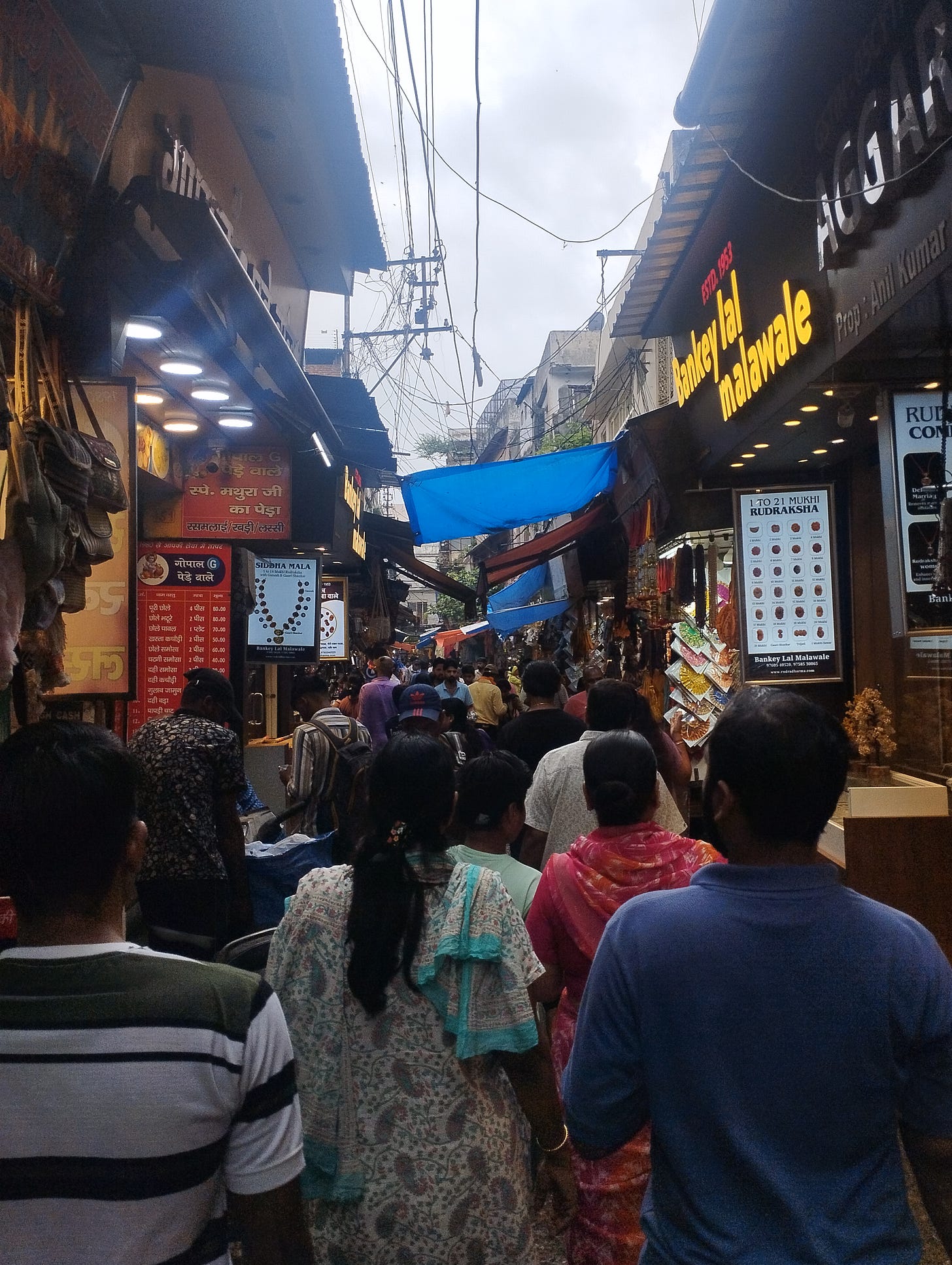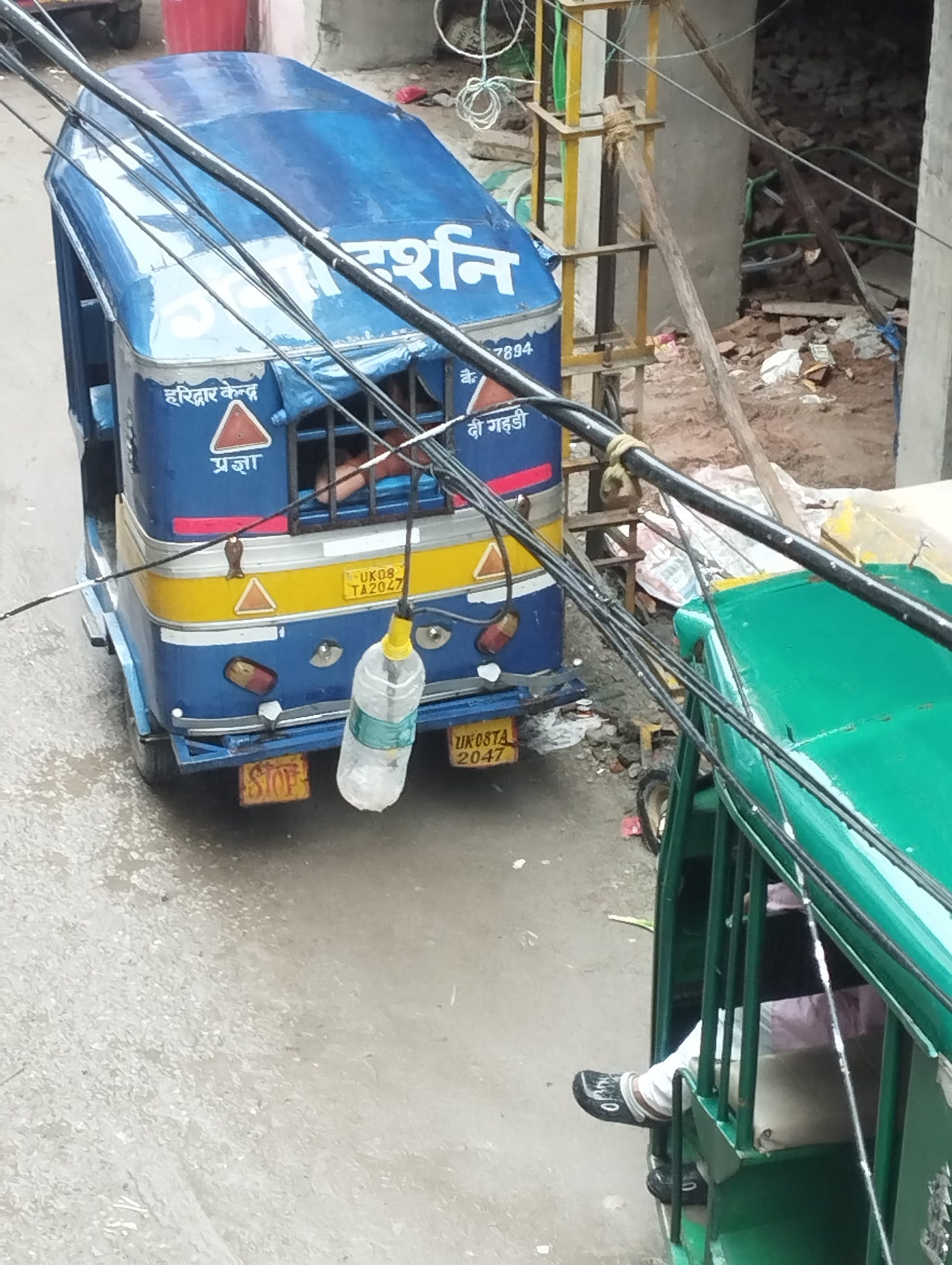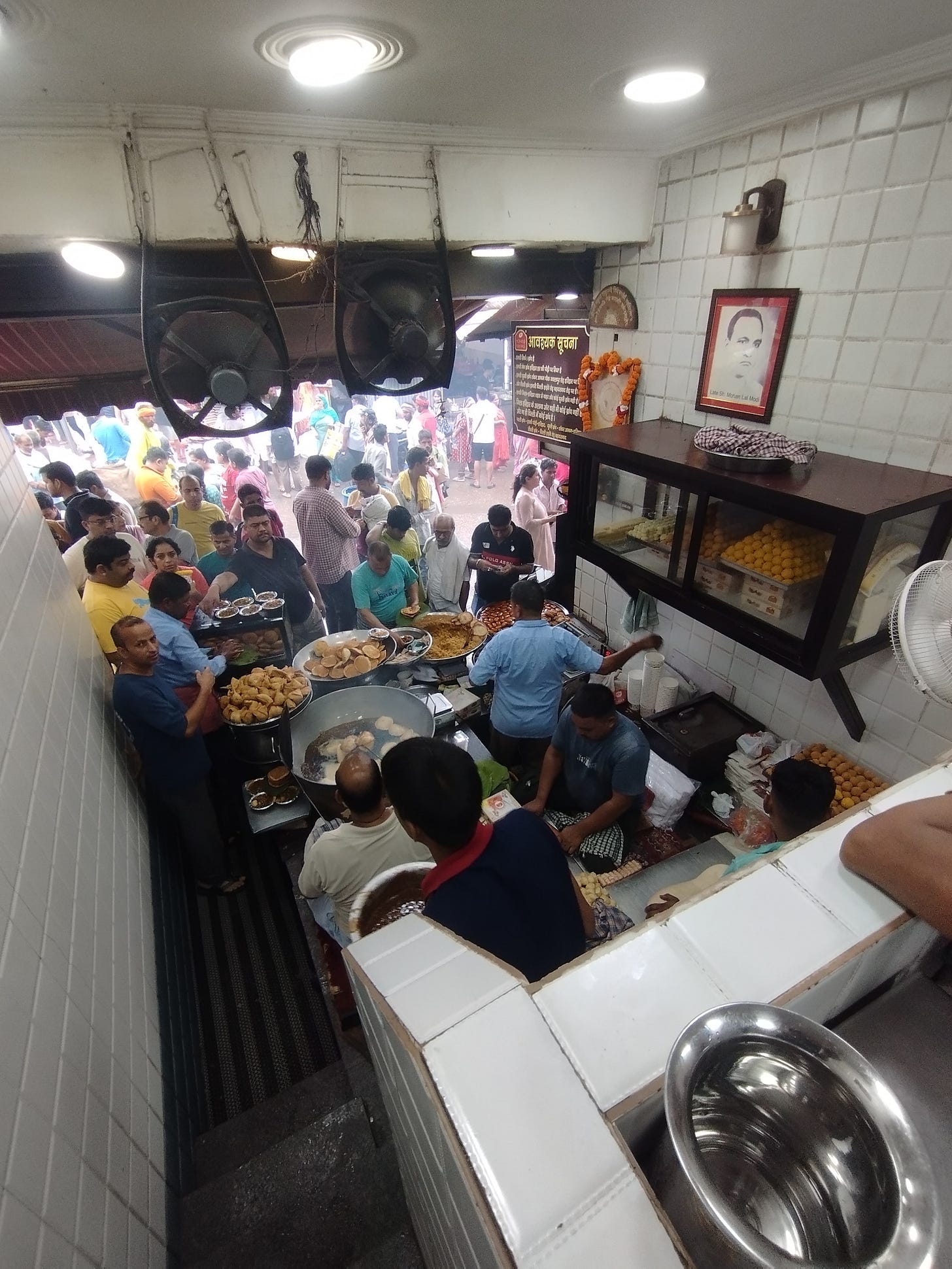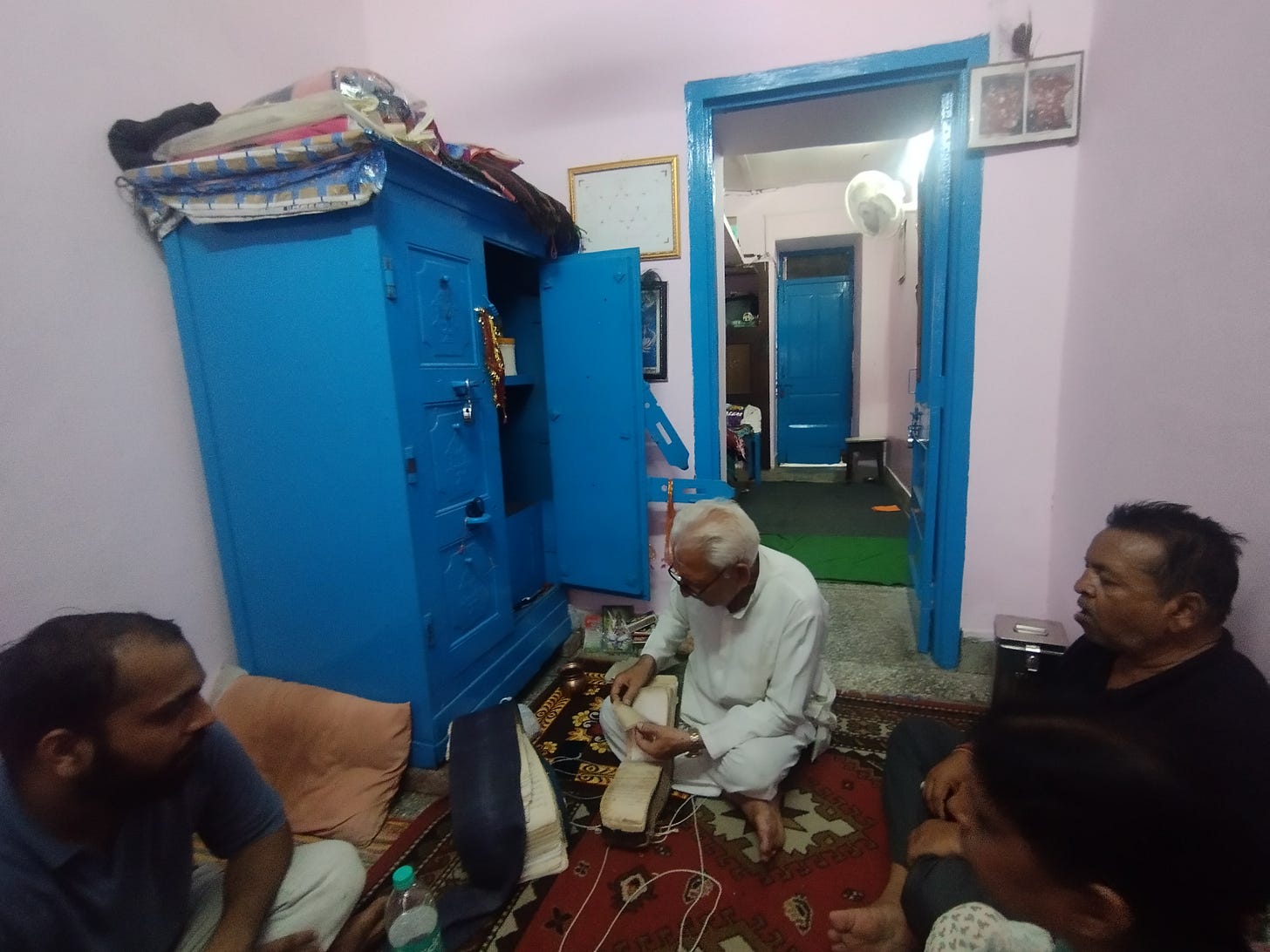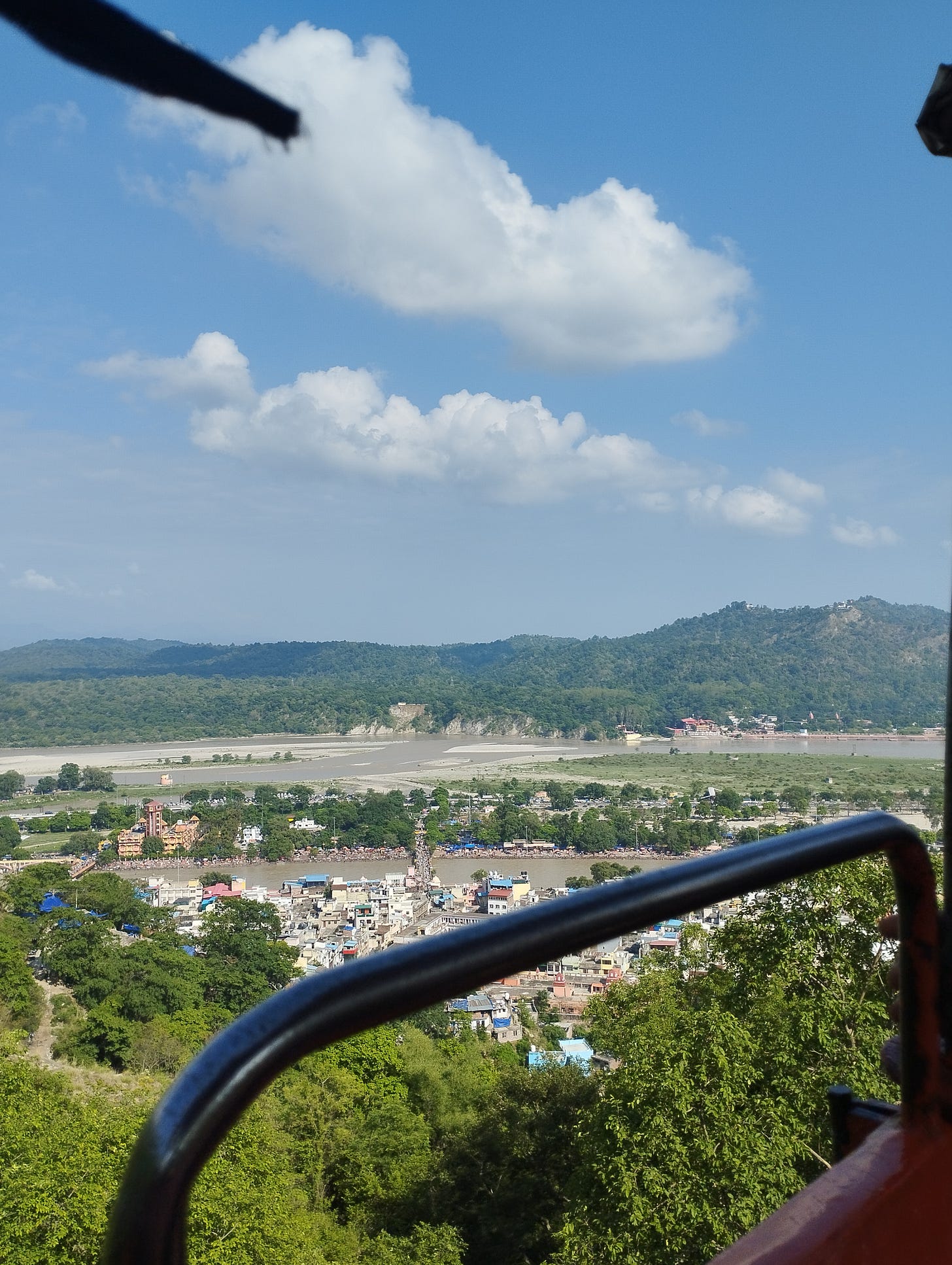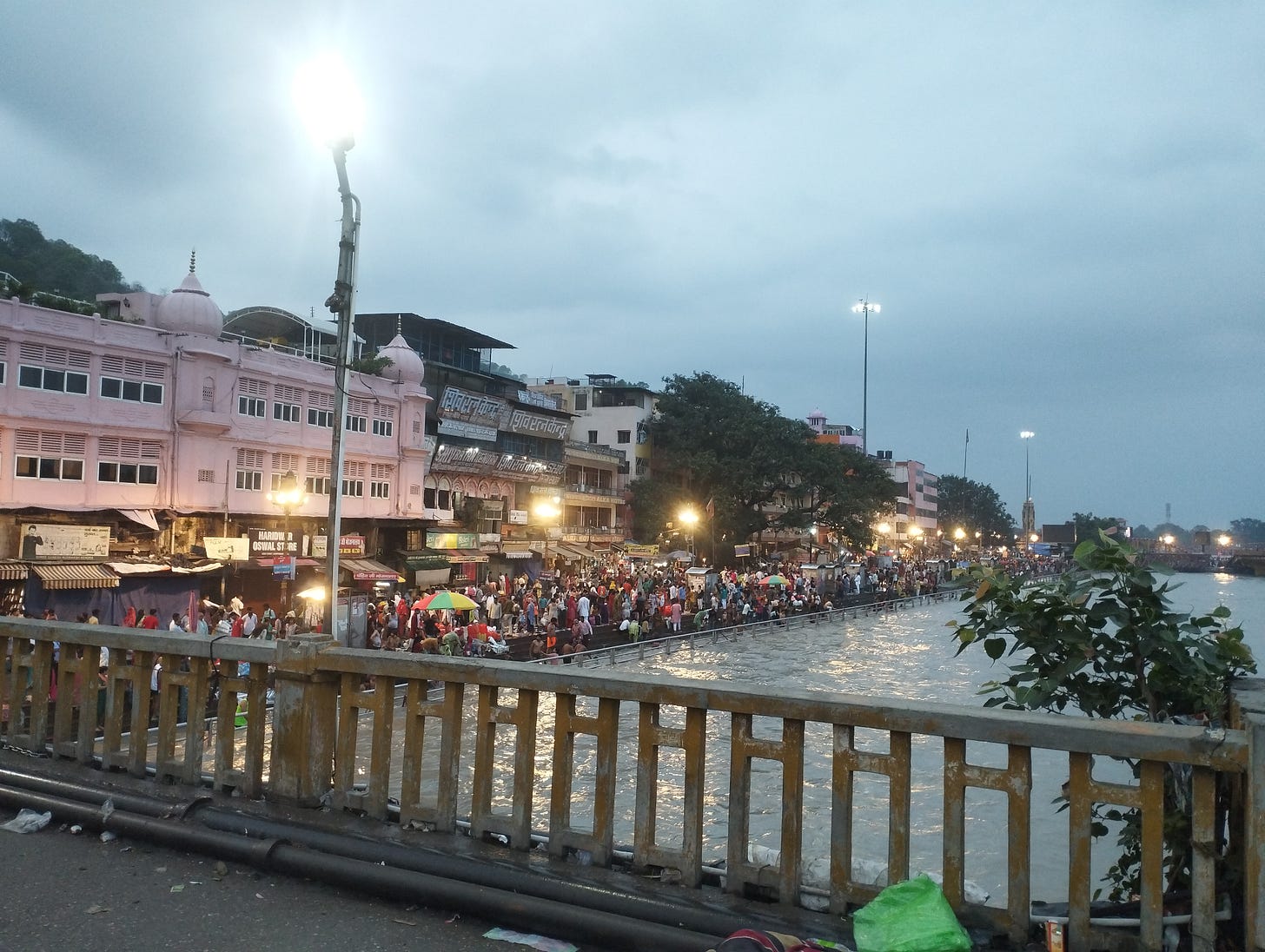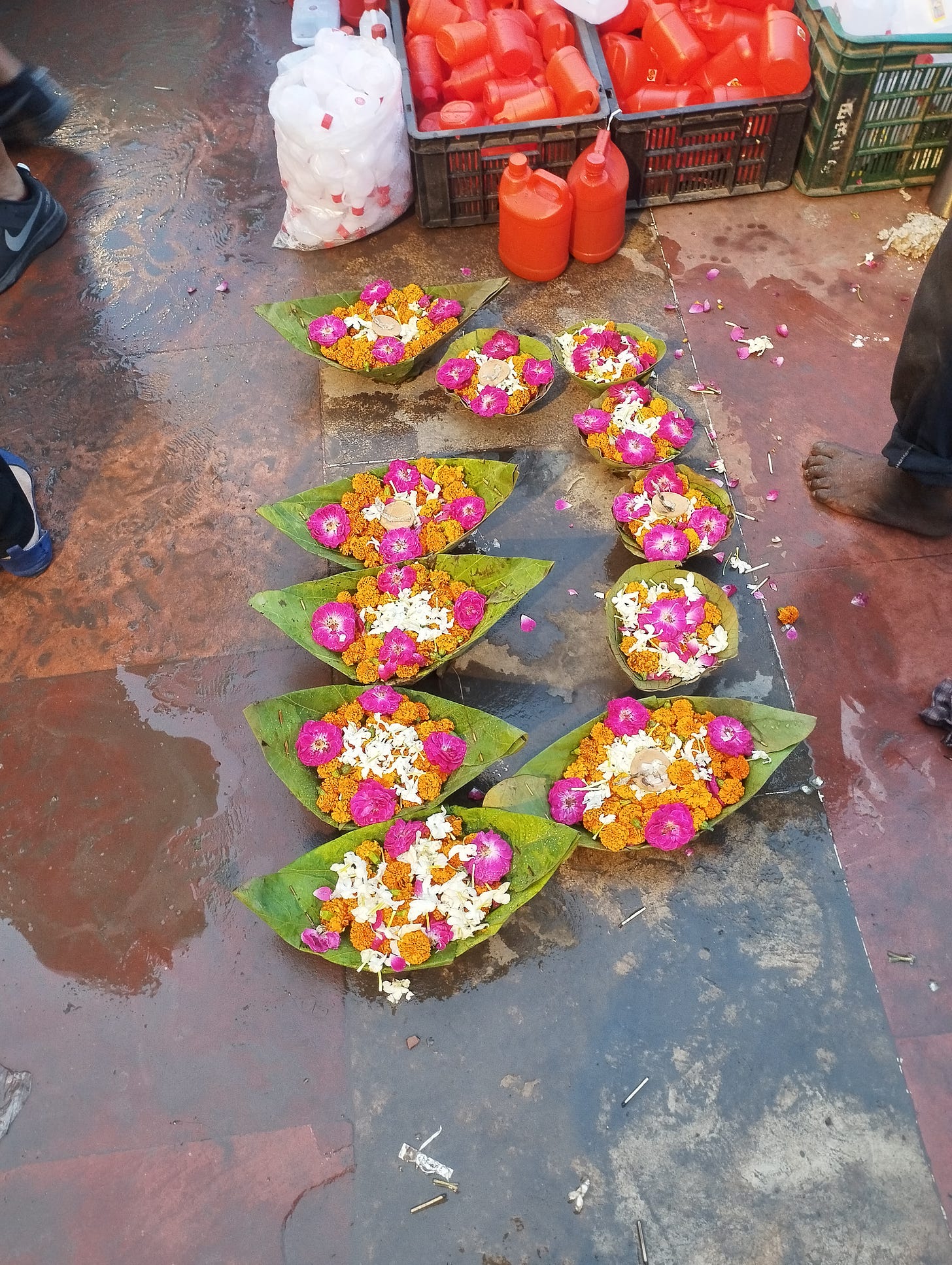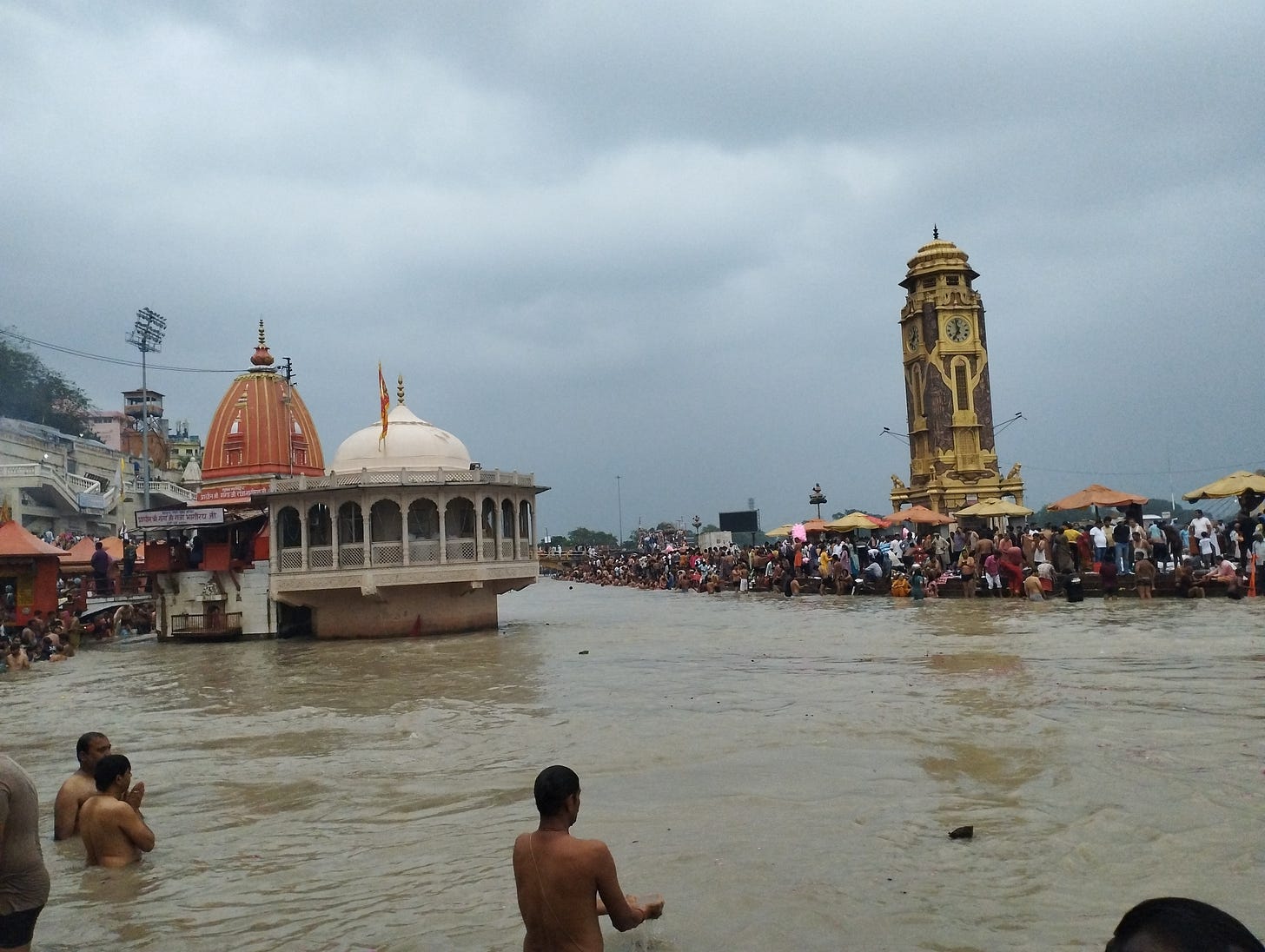Please Remove Your Shoes Before Polluting the River
An essay on the culture, cuisine and contradictions in the city of Haridwar
Let’s begin this with a rather important update. The reason my blogs and the Don’t Just Take CS(E) series are paused is because my grandmother passed away earlier this month.
This post will have some discussion of Hinduism. Being a curious person, I will ask some questions here and there. If you are a Hindu and feel that I should not ask too many questions and just take the word of God, please refer to Vedanta Sutra (1.1.1) from Brahma Sutra (athato brahma jijnasa: Without inquiry about the Supreme, no wisdom can be gained).
Any intellectual disagreements are more than welcome and we can discuss/duke it out in the comments. As well as, if you want to know more about any of the the other things, feel free to just ask.
Haridwar is a holy city in Uttarakhand. It is situated on the banks of river Ganga, considered sacred by Hindus.
The name of the city can be broken down in two ways: Hari + Dwar and Hara + dwar (the ‘a’ sound changes to ‘i’ sound at joining) which mean “gateway to Vishnu” and “gateway to Shiva” respectively.
This town is mostly visited to start a pilgrimage or is visited after a loved one dies. I was there for the latter, along with my tauji (my father’s elder brother), my taiji (Tauji’s wife) and cousin elder brother, who are way more religious than I am. I just happen to have read a lot of mythology.
I will now, through this essay, try to convey to you everything I was thinking about. I was texting a college senior about my frustrations and philosophies throughout this 48 hour period. This is an extension of those thoughts.
One of the first things one notices about Haridwar is that the city doesn’t seem too developed. This is somewhat intentional, to project the idea of ‘connected to roots’ and ‘holiness’. With a large part of the city being foot only combined with the old typography and street food, it does feel like the quintessential old Indian city.
I did drink a lot of lemon soda and cumin soda during these two days from these street stands.
The cost of travel, in the parts where automobiles are allowed, using auto-rickshaws (displayed in photo above) from almost any two points in the city is 20 INR. Makes sense considering the city has a radius of barely 12 km.
Considering that recently India’s education board was pressured to pluck out Mughal history from the curriculum, and in place promote the (rather obvious) lie. that our country has been independent from rest of the world, run only by Hindus. I find it incredibly funny to go to this Hindu city and see Islamic influence in the architecture.
Fact of the matter is that the Mughals, whom we want to label as thieves and invaders, as destroyers of temples and fanatics; interestingly renovated this city. Haridwar was renovated during Akbar’s rule, overseen by Raja Maan Singh. The main ghats (river-front) of Ganga was constructed by them. 400 years later, It is still mostly the same.
Raja Maan Singh, being Hindu, had his ashes immersed in the part of the river front called Brahama Kund.
Potatoes and Chickpeas are common food at religious sites. These are carb rich gravies which are filling, tasty and give the energy for the extended walking people do to reach temples. They also are easy to prep and hard to make errors in. Overcooking them or undercooking them to a noticeable amount is much harder than a lot of other foods. Pair them with hot poori (wheat based fried bread) or Kulcha (a type of stuffed flatbread, if you know Naan, it is stuffed Naan) and aachar (oil + lemon based pickles), and you are good to go.
Interestingly, potatoes were brought to India by Portuguese sailors, mostly catholic and chickpeas from Afghanistan through Arab traders.
While both are now cultivated in India, the fact that these are often offered as Prasad (offering to god, later distributed to people) tells a lot about how welcoming Indian people and Indian culture was. It is a shame that a culture defined by its ability to absorb and transform the foreign into the familiar is now being taught to fear its own rich and varied history.
Talking about history, one can find the Hindu genealogy records here. These are records kept by the family priests, updated after every demise in the family. Marriages, new kids etc are added as well as contact details are changed. While the records of my family are some 200-300 years old at best, the oldest in the city are 900-1000 years old.
I always felt that some highly intelligent scheme must be used to maintain and find these data. Well, being a CS person, I tend to spend a lot of time thinking about the very complex data structures around us, one of which is allowing me to type this post (it is called a rope). So I was expecting something smarter than literally a spreadsheet.
But then again, considering this is the simplest and easiest to maintain paper solution and given a systemic scheme, is robust enough. Fun Fact: Netflix had excel files in the codebase till 2019, before switching to SQL.
Let’s talk about some religious hypocrisy. Understand that I was the youngest person here and unlike my parents, my tauji-taiji believe in experience model of life aka if you are elder, you are right.
So despite our family priest telling us that we are not allowed to go to temples. Despite the evening Ganga aarti (we will come back to this) being the main attraction of this city, we went to two major temples with cabal cars. Missing the evening aarti.
Mansa Devi and Chandi Devi temple are quite close to Haridwar. So people tend to visit them when coming to Haridwar, unless specifically prohibited (even then, some people don’t listen).
Both Mansa Devi and Chandi Devi are forms of Shakti. Here is a small dive into Hindu theology: Shakti is the universal energy creating and sustaining all existence. She is the goddess. But then we have other goddesses as well. Some are known to be forms of Shakti and other are independent.
So what is going on? Hindu traditions originate from different sets of texts. The Vedas and the Purans. Based on your families beliefs and your personal choice, people choose what tradition to follow.
There are Vaishnavs (who believe in mostly the Puranic tradition and worship Vishnu), the Shaivas or Shaivites (who believe in mostly a mix of Puranic and Vedic traditions and worship Shiva) and Shaktas (who believe in mostly the Vedic tradition and worship Shakti). These are the old traditions. A lot of people follow a mix of these as well as some have their own family traditions. And then, there is always choice.
While the worship of Shakti is pre-Vedic, somewhere or the other, she was no longer the only goddess despite being the goddess. Now, the how and why is debated. But we know that the worship of Shakti took a dip during the Puranic period as the society slowly became more patriarchal and people didn’t wish to worship an all powerful female. The worship was eventually revived. The details and the time period, unfortunately, are quite murky.
When speaking of Shakti, we could be speaking of either the benign and graceful or the fierce and protective side.
Mansa Devi is the former, Mansa literally means wish. The goddess is believed to fulfill the wishes of her true devotees.
Chandi Devi is the latter. She was summoned when two demons pulled gods from the heavens and wrecked havoc. Chandi Devi slayed these demons, who were so enormous that they are literally mountains now, and then took rest on another mountain. That is where the temple is.
While people could show true passion and zeal and climb these hills and visit these temples in the old way, most people are lazy. So they instead, they take a cable car.
Unfortunately, I am not very proficient with mechanical engineering, so I can’t tell you much about how the cable car operates or any fun facts about it. The system looked quite cool, here are pic of one of the mechanisms.
Let’s now talk about Ganga. Ganga is a river and a goddess. Her domain is purification and forgiveness. She is also one of the only goddesses independent of Shakti in Vedas. She also plays a role in the Purans, especially in Mahabharata, where she is at the catalysis of the epic.
While there is a lot of theological debate on Ganga and how the river came to Earth, for our purposes, you need to know two things
Ganga is worshiped almost universally by Hindus (irrespective of tradition)
The ashes and bones of the deceased are often submerged in Ganga to make the path to afterlife easier. Furthermore, the living also take a dip in the river to cleanse their sins (we will talk about this in a moment).
One can expect that this makes the river quite holy. People don’t even step in the river with footwear, so as to not pollute it. After all, it provides water to 400 million people.
Surprise, Surprise, It is the most polluted river in the world. People living close to the river have a highest rate of cancer than anywhere in the country. The river’s water is so polluted that 2/3 of people who take regularly take a bath in Ganga get some sort of water-borne or gastrointestinal disease.
How does this happen? The untreated sewers of these cities made around this river are dumped in the river as well as the mining and petrochemical industry using it as their trash bin. I’ll make it very clear, a majority of these city boards and the directors of these industries is Hindu. They are well aware of the holy status of this river. They just like money more.
30 Billion USD have been spent in the last decades to clean Ganga. This has not been successful because of corruption and use of unscientific techniques.
Well, there is this extremely grand aarti done at morning and evening. For those who don’t know, Aarti is a hindu ritual involving the waving of light (often from a lamp or candle) before a deity, accompanied by devotional songs or hymns. It is a form of worship and a way to express love, reverence, and gratitude towards the deity
It is extremely picturesque in the evening, started at sunset and is carried out well into the dawn. It is 15 ish minutes in length.
I didn’t get to attend this and I am still salty about that.
We ate food at a restaurant and then planned to go for the morning aarti.
Well, the people around me don’t understand much math or science, so they decided that the sunrise always happens at 6 and hence, we will go to river front at 5:30. Well, the sunrise happened at 5:20 and the morning aarti is shorter and of 8 minutes. So, we missed it. Atleast the aarti plates were still lit, so we got to take the blessings.
As the photo indicates, there were flower lamps. These are quite cute and people normally wish for something before leaving them in the river. I didn’t do that.
I also was forced to take a bath in the river. I knew the pollution stats. But elders kept forcing. I first tried to act scared of water., but then an elderly couple wanted to fill one of the plastic containers with water and were scared to go towards the deeper part of the river, with a faster flow. “I knew how to swim since the age of 9, I just went ahead and did that for them. With the facade broken, eventually, I was pressured into taking a dip (going inside with your complete head). I got a viral soon after.
A very fun fact about Ganga washing sins Hindu texts describe three types of sins based on severity.
The lowest kind has small things. Killing a bug by chance, minor theft etc. These are quite easy to be forgiven for and can be washed away by Ganga.
The other two, consists of crimes causing immense harm to people. Like murder, violent theft, mass fraud etc; and crimes which would shake ones opinion of humanity like genocide, rape etc respectively. These both are not washable by simpy taking a dip. The former while can be atoned for through guilt and better deeds further in life, the latter are unforgivable.
Also, a lot of Indians are against showing too much skin, especially women. They often say “Swimming costumes and Bikini’s and Crop tops are western things and are eroding are nations values.”
Well, then why are these people A-ok with women, even very young girls, to be topless in Ganga, in public? As a person, I don’t mind people doing either of these, free will and personal choice. But please be consistent in your opinion.
Anyways, to the bunch of dudes I saw in the river who felt it is a good idea to eve tease these girls; remember, not all sins can be washed. Like, this close to a river goddess who is believed to be destructive when her and her subjects’ respect is messed with, you decided to do what you did, I recommend having some fear of god, if not of law.
Anyways, once we were purified by the bathe in the river, we did the ritual and submerged the ashes of my grandmother in the river.
And then after going to some other temples (because why not?), we take the train back home. On this journey back home, I met two extremely interesting people. I will talk about this conversation some other time.
This is one of the posts which was written in the flow, without much structuring. So if you enjoyed this, please consider pressing the heart button.
If this post is something you learnt something new from, consider subscribing. It is free and will get you more curious things in your inbox.
If you have any comments or questions on the topics discussed (or not), please leave a comment and we can have a discussion.
Other than that, thanks for reading.
Warm Regards,
Arjun Maneesh Agarwal.


